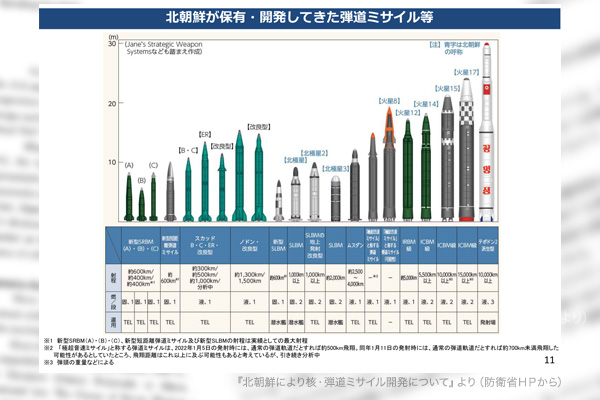On October 10, North Korea announced that its seven missile launches between September 10 and October 9 were “military drills” by the “tactical nuclear operation units,” guided by its leader Kim Jong Un.
As I have reiterated, there are two kinds of North Korean missile launches: tests by the Academy of National Defense Science and drills by military forces. The academy under the Korean Workers’ Party’s Munitions Industry Department undertakes the development of nuclear missiles and conducts their test launches. After missiles are developed and deployed, they are used for drills by military forces. The announced drills mean that these missiles have been developed and deployed.
Simulated tactical nuclear attacks
North Korea launched 26 missiles from last year to August this year. Most of them were test launches. (Of the 20 launches from last year to April this year, only two were conducted by a railway-borne missile regiment. Six launches between May and August were not covered by official reports.)
The missiles launching drills this time were “simulating the loading of tactical nuclear warheads.” Simulated targets were “airports in the operation zones of South Korea” on September 28, “enemies’ main military command facilities” on October 6 and “enemies’ main ports” on October 9. The last two groups of targets may include U.S. bases in Japan and Guam, as well as Japan’s Self-Defense Forces bases and ports in Japan.
The launch of a “new-type ground-to-ground intermediate-range ballistic missile” or a Hwasong-12 missile that flew above Japan on October 4 also represented a drill by the tactical nuclear operation units. In 2017, two Hwasong-12 missiles were fired for flights in the same conventional orbits above Japan as for the latest one. Then, the launches were reported as drills by the Korean People’s Army Strategic Force. The latest launch indicated a potential nuclear attack on Guam more explicitly. North Korea might be preparing for a tactical nuclear explosion test after China’s Communist Party Congress, according to insider information.
As I wrote for the Rondan (Viewpoints) column on September 20, Kim Jong Un is now gripped in two fears. One is about the U.S.-South Korea military alliance that has been rapidly normalized since the inauguration of South Korean President Yoon Suk Yeol. The other is about North Korean people’s growing discontent with hard living under international sanctions and a border closure. To break through the fears, Kim attempts to pressure the U.S. Biden administration into easing sanctions while securing his own safety through the military provocations using nuclear missiles.
Keep military pressure and enhance sanctions
Pyongyang’s current emphasis on short- and intermediate-range missiles, which differs from its focus on the development of intercontinental ballistic missiles reaching the U.S. mainland in 2017, may anticipate a deal with the Biden administration that may include officials who are ready to admit North Korea as a nuclear-armed country unless it has ICBMs.
In 2017, the Japanese government of Prime Minister Shinzo Abe concluded that the Self-Defense Forces could intercept Hwasong-12 missiles bound for Guam. Japan and the United States then maintained military pressure on North Korea and won United Nations Security Council resolutions to impose sanctions that deprived North Korea of most of foreign currency income. As a result, Kim Jong Un agreed to hold a meeting with then U.S. President Donald Trump without winning the lifting of sanctions or assistance.
Prime Minister Fumio Kishida should follow suit of Abe. The Kishida administration should warn the Biden administration against any easy concessions to North Korea, encourage the United States and South Korea to exert military pressure on North Korea and impose tougher sanctions on North Korea. Japan should lead the North Korean dictator to understand that the past practice to take advantage of growing tensions to win the relaxation of sanctions or assistance would not work.
Tsutomu Nishioka is a senior fellow and a Planning Committee member at the Japan Institute for National Fundamentals and a visiting professor at Reitaku University. He covers South and North Koreas.


